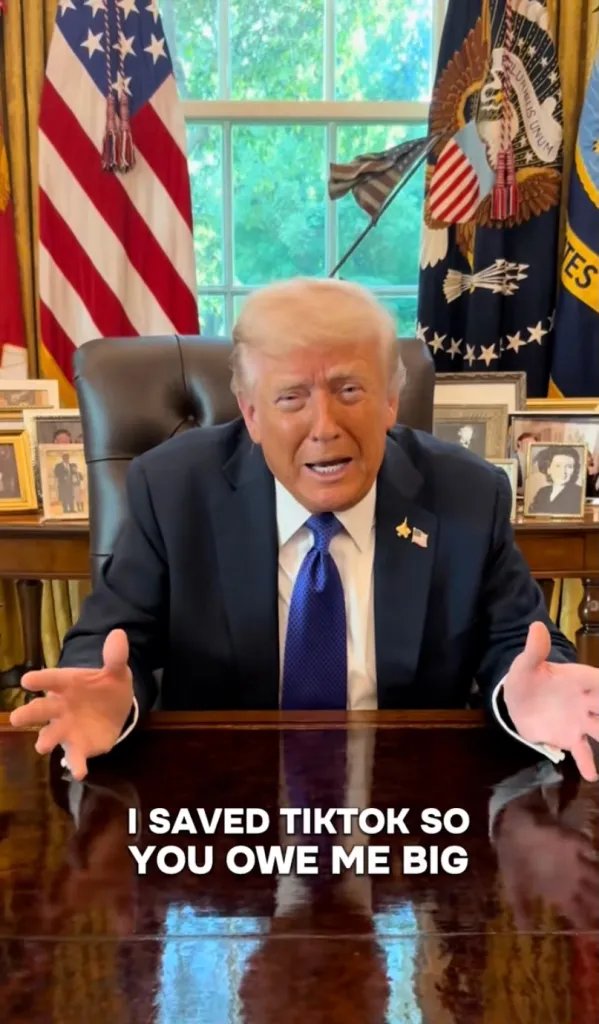Trump Returns to TikTok, Claims He “Saved” the Platform for Gen-Z
In a surprising move, former President Donald Trump has re-entered the social media landscape by returning to TikTok, a platform that has become a cultural phenomenon among younger audiences. In a video posted on Monday, Trump addressed his Gen-Z followers, declaring, “I saved TikTok, so you owe me big.” This statement marks his first appearance on the app in nearly a year, reigniting discussions about his influence on social media and the ongoing saga surrounding TikTok’s ownership.
A Comeback Amid Controversy
Trump’s return to TikTok comes at a time when the platform is navigating complex regulatory waters in the United States. The former president’s administration had previously attempted to ban TikTok over national security concerns, citing fears that user data could be accessed by the Chinese government. However, recent developments indicate a shift in strategy, with Trump now positioning himself as a savior of the platform.
In his video, Trump also made a nod to the future, stating, “Now, you’re looking at me in the Oval Office, and someday one of you are gonna be sitting right at this desk, and you’re gonna be doing a great job also.” This statement not only appeals to his younger audience but also reinforces his ongoing narrative of political ambition and influence.
Vice President Vance Joins the Fray
Joining Trump in this digital revival is Vice President JD Vance, who also relaunched his TikTok account shortly after Trump’s announcement. Vance expressed his gratitude, saying, “Glad to be back on TikTok thanks to President Trump!” His return signals a broader strategy to engage younger voters through platforms they frequent, a tactic that has become increasingly important in modern political campaigns.
Vance’s TikTok presence aims to provide updates from the White House while also promising a lighter touch with “some sombrero memes.” This blend of serious political messaging and humor reflects a growing trend among politicians to adapt their communication styles to resonate with younger demographics.
The Future of TikTok in the U.S.
The backdrop of Trump’s return is a proposed deal that aims to transfer majority control of TikTok to a consortium of American investors. This initiative is part of a broader effort to alleviate national security concerns while keeping the app accessible to U.S. users. The deal, which Trump has publicly supported, would involve licensing the algorithm that powers TikTok, a key component of its success.
Tech giant Oracle is set to play a significant role in this new arrangement. As a confirmed partner in the investment consortium, Oracle would be responsible for auditing the algorithm and ensuring that U.S. user data remains secure from potential Chinese access. This framework aims to address the concerns that have plagued TikTok since its rise to prominence in the American market.
Historical Context: The TikTok Saga
The saga of TikTok in the United States has been fraught with political tension and public scrutiny. Launched in 2016, the app quickly gained popularity, particularly among younger users, who embraced its short-form video format. However, its ownership by the Chinese company ByteDance raised alarms among U.S. lawmakers, leading to calls for a ban and various legal challenges.
In 2020, the Trump administration attempted to force a sale of TikTok’s U.S. operations to an American company, citing national security risks. This move was met with legal battles and public outcry, ultimately leading to a stalemate. The Biden administration has since taken a more measured approach, focusing on negotiations rather than outright bans.
The Role of Social Media in Politics
Trump’s return to TikTok underscores the growing importance of social media in political discourse. Platforms like TikTok have become essential tools for politicians seeking to connect with younger voters, who are increasingly disengaged from traditional media. The ability to create viral content and engage directly with constituents has transformed the political landscape, making it imperative for leaders to adapt to these new communication channels.
Moreover, Trump’s statement that Gen-Z “owes” him for saving TikTok reflects a broader strategy of leveraging social media to build a personal brand and maintain relevance in a rapidly changing political environment. This approach is not unique to Trump; many politicians are now using platforms like TikTok to humanize themselves and foster a sense of community among their followers.
Conclusion
Donald Trump’s return to TikTok is more than just a personal comeback; it represents a significant moment in the ongoing narrative of social media’s role in politics. As the platform navigates its future in the U.S. under new ownership, Trump’s influence and the engagement of figures like Vice President JD Vance highlight the importance of connecting with younger audiences. The evolving landscape of social media will undoubtedly continue to shape political strategies, making it essential for leaders to adapt and innovate in their communication efforts.











